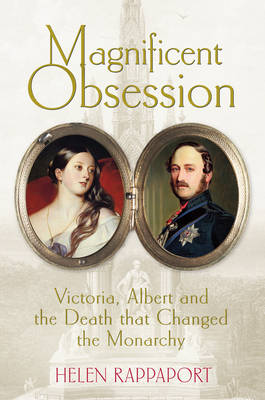When Queen Victoria's husband, Prince Albert, died in December 1861 the nation was paralysed with grief. He was only forty-two and official bulletins had, until the day before he died, given no cause for alarm.
But in fact Albert had been in a progressive physical decline for years - worn out by overwork, stress and the exacting standards he set himself. His death was a catastrophe for the queen, who not only adored her husband but had, through twenty-one years of marriage, utterly relied on him: as companion, father of their children, friend, confidant, wise counsellor and unofficial private secretary. There was not a single aspect of public business on which she had not deferred to his advice and greater wisdom. She would even consult him on what bonnet to wear.
Britain had lost its king. For that is the role that Albert had performed in all but name. Politicians and the press agreed that his death was a national calamity. The public, totally unprepared, responded with a massive outpouring of grief.
This royal death had a profound impact on Britain. Cast adrift and alone, the Queen donned the widow's weeds that she would wear for 40 years, till her own death in 1901. Her grieving was relentless. Without Albert to guide and support her, with a feckless heir who had caused her nothing but anxiety, and a family of nine children to parent alone, she retreated into a state of pathological grief which nobody could penetrate and few understood. Her stubborn refusal to return to public life rapidly began to alienate even her closest family and friends and to bring a resurgence of republicanism. There was even talk of abdication.
For the 150th anniversary of Albert's death, this book examines the circumstances leading up to it, the ritual of his funeral and obsequies, and offers new theories on what killed him. It will describe the overwhelming despondency of a country plunged into mourning: bells tolling, shops shuttered up, everyone - no matter how poor - clad in black. Albert's death and the Queen's demand for the most rigorous observance of mourning, while precipitating months of anxiety about its effect on business, also fostered an explosion in the funeral trade and mourning ephemera. The Whitby jet trade went into overdrive to cope with the demand for black jewellery. Over the next ten years, the Queen's single-handed mission to memorialise and commemorate her husband in perpetuity set in train plans for a range of artistic and cultural monuments that would transform the British landscape and set their visual stamp on the second half of her reign.
- ISBN10 0091931541
- ISBN13 9780091931544
- Publish Date 3 November 2011
- Publish Status Out of Print
- Out of Print 2 May 2015
- Publish Country GB
- Publisher Cornerstone
- Imprint Hutchinson
- Format Hardcover
- Pages 352
- Language English
